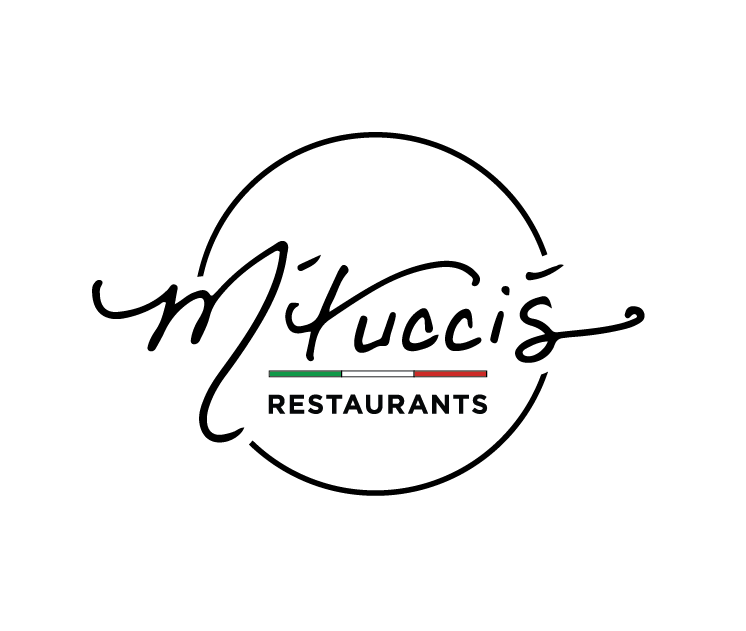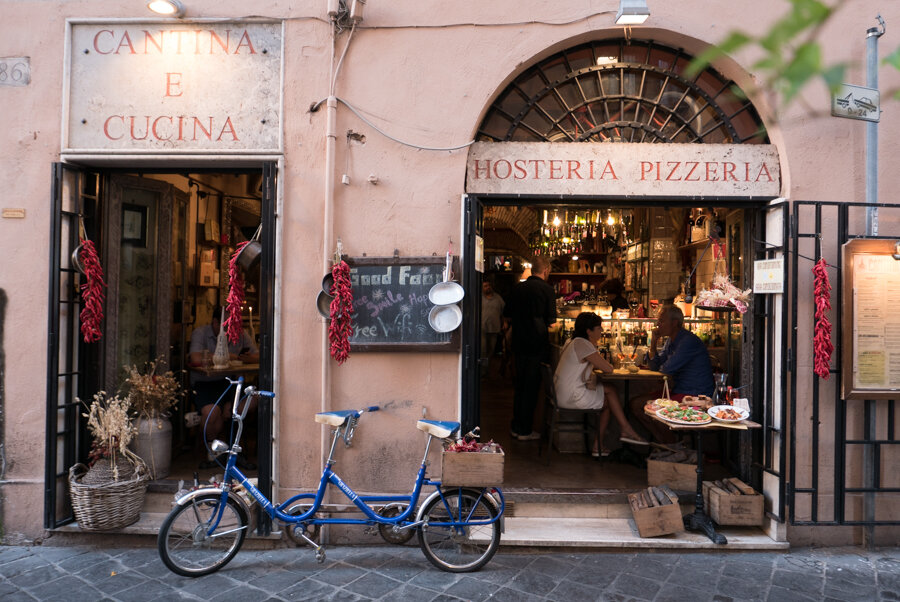Italian Trattorias
/Editor’s Note: I am on vacation this week, but we are honored and excited to feature an excerpt from an essay in Pasta, Pane, Vino by James Beard Award-Winning author Matt Goulding. Probably one of the best books written about Italian food and travel, Pasta, Pane, Vino takes the reader on a culinary adventure throughout the peninsula. A more detailed bio and a link to his books follow the essay.
In the chapter about Rome, he answers the question (with great examples): what is a trattoria? When I read his description, I thought, “he just described M’tucci’s.
We hope you enjoy it enough to buy the book, in addition to the other two in the series about Japan and Spain. Read on.
Rome
“Ristoranti, the most formal class of dining in Italy, have the prices and the worldly clientele to experiment, but the heart of Italian food culture, especially Roman food culture, is the trattoria, an institution historically built on an infallible formula: good product, unfussy technique, reasonable prices. According to my friend Alessandro, there are only a few true trattorie left in Rome, and he dispatches me to one with a friend, Andrea Sponzilli, another intrepid food writer. “He’ll know what to order.”
Among the pillars of Italian cuisine, pasta is the most sacred—the one that has inspired thousands of books, millions of journeys, and infinite debates about the way to do it right.
The rest of the world openly wonders what makes Italian pasta so good and theirs so mediocre, but the answer is right in front of their faces: the pasta itself. The bond between flour and water (and in some cases egg) is sacrosanct, and it must not be broken unnecessarily, compromised by sloppy cooking or aggressive saucing or tableware transgressions. That means cooking it properly, ignoring package or recipe instructions and instead relying on a system of vigilant testing until only the barest thread of raw pasta remains in the center of the noodle. That means saucing it sparingly, in the same way a French chef might dress a salad, carefully calibrating the heft and the intensity of the sauce to the noodle itself. That means refraining from unholy acts of aggression: throwing it against the wall, adding oil to the boiling water, spinning the pasta against your spoon, or for God’s sake cutting the noodles with a knife and a fork. Above all, that means thinking not addition but subtraction, not what else can I add, but what can I take away?
Italian cuisine, at its very best, is a math problem that doesn’t add up. A tangle of noodles, a few scraps of pork, a grating of cheese are transformed into something magical. 1 + 1 = 3: more alchemy than cooking.
No strain of regional Italian cooking expresses that more clearly than the iconic pastas of Rome: gricia, carbonara, amatriciana, and cacio e pepe. “They are the four kings,” says Andrea as we peruse the menu of Cesare al Casaletto, a trattoria in Monteverde. It’s ten minutes from the center of Rome, but for tourists who rarely cross the Tiber except to dip a toe in Trastevere, it might as well be in Florence. Our table of four decides to divide the royalty among us, and when the four dishes arrive, a silence falls over us. There’s a near-spiritual significance to having these four pastas on the table at once—each revered enough to have achieved canonical status among carb lovers the world over, but none containing more than a handful of ingredients.
Carbonara: The union of al dente noodles (traditionally spaghetti, but in this case rigatoni), crispy pork, and a cloak of lightly cooked egg and cheese is arguably the second most famous pasta in Italy, after Bologna’s tagliatelle al ragù. The key to an excellent carbonara lies in the strategic incorporation of the egg, which is added raw to the hot pasta just before serving: add it when the pasta is too hot, and it will scramble and clump around the noodles; add it too late, and you’ll have a viscous tide of raw egg dragging down your pasta.
Cacio e pepe: Said to have originated as a means of sustenance for shepherds on the road, who could bear to carry dried pasta, a hunk of cheese, and black pepper but little else. Cacio e pepe is the most magical and befuddling of all Italian dishes, something that reads like arithmetic on paper but plays out like calculus in the pan. With nothing more than these three ingredients (and perhaps a bit of oil or butter, depending on who’s cooking), plus a splash of pasta cooking water and a lot of movement in the pan to emulsify the fat from the cheese with the H2O, you end up with a sauce that clings to the noodles and to your taste memories in equal measure.
Amatriciana: The only red pasta of the bunch. It doesn’t come from Rome at all but from the town of Amatrice on the border of Lazio and Abruzzo (the influence of neighboring Abruzzo on Roman cuisine, especially in the pasta department, cannot be overstated). It’s made predominantly with bucatini—thick, tubular spaghetti—dressed in tomato sauce revved up with crispy guanciale and a touch of chili. It’s funky and sweet, with a mild bite—a rare study of opposing flavors in a cuisine that doesn’t typically go for contrasts.
Gricia: The least known of the four kings, especially outside Rome, but according to Andrea, gricia is the bridge between them all: the rendered pork fat that gooses a carbonara or amatriciana, the funky cheese and pepper punch at the heart of cacio e pepe. “It all starts with gricia.”
And that’s where I start, lifting the pasta from the big-bellied bowl and marveling at its humility: nearly naked, with only the faintest suggestion of human interference. To truly enjoy a pasta of this austere simplicity is to surrender yourself entirely to the scope of its achievement: How to extract so much from so little? How many ingredients in any other cuisine around the world would it take to create a dish as satisfying as this one? Why doesn’t my pasta taste like this?
You could argue that the two central ingredients at the heart of Rome’s pasta culture aren’t really ingredients at all: the first is water. Not just any water, but the water used to cook all those batches of pasta throughout service, each successive batch of noodles leaving behind a layer of starch that steadily transforms the water into an exquisite binding agent, perfect for adding to a pasta sauce to adjust the consistency and clinginess.
The other vital ingredient in the Roman pasta canon is a simple but vital technique: a flick of the wrist, the aggressive movement needed to emulsify the cooking water with the fat in a pan of pasta sauce. By swirling the pan with one hand and using a set of tongs with the other to keep the starch in constant motion, like a Cantonese chef taming the breath of the wok with a hand that never stops moving—what Italians call la mantecatura—a thirty-second mating ritual of intense amorous energy wherein pasta and condiment become one. Without water and without the wrist motion, cacio e pepe would be nothing more than pasta dressed with cheese and pepper, gricia would be noodles in a mess of rendered pork fat. (Of course, most non-Italian cooks don’t even attempt this delicate dance, opting instead to go the route of poor Nigella, adding cream to their carbonara and cacio e pepe.)
The Cesare specimens are among the finest I’ve tasted. Using rigatoni instead of spaghetti for carbonara would evoke an avalanche of angry Facebook posts from pasta purists, but there’s no doubt that the hollow shape makes a more generous home for the silky sauce. The gricia is deserving of its fame across the city, the toothsome strands of housemade tonnarelli robed in a soft blanket of warm pig fat and pecorino. And the cacio e pepe, well, let’s just say the cacio e pepe will follow me everywhere across this country in the months to come, a three-ingredient measuring stick for the greatness of Italy’s regional cuisine. Albert Einstein said he saw the possibility of a higher power in the harmony of the natural world; some find it in the magnificent complexity of the human body. I see it in the miracle of cacio e pepe.
Before the hushed reverence of our pasta moment threatens to turn lunch awkward, the sound of happy eaters snaps us out of our silence. “The story of Roman cuisine is the story of the neighborhood restaurant,” says Andrea. “Any real romano will always believe the best osteria is next door. Their loyalty is always to the neighborhood.” You can feel that loyalty in the room today: parents linger over dessert as their kids play under the table, old couples hold hands as they finish off the last few sips of wine. Maybe some have made the trip from other parts of Rome—it’s certainly worth it—but chances are that most live within strolling distance.”
If that doesn’t make you want to go to Rome and eat, I don’t know what will. Thanks Matt!
Used with permission From Pasta, Pane, Vino - Deep Travels Through Italy’s Food Culture by Matt Goulding, an Anthony Bourdain/HarperCollins book (2018)
Matt Goulding is an Emmy and James Beard Award-winning author and producer, now based in Barcelona. The former food editor at Men’s Health, he is the author of the very popular Eat This, Not That and the co-founder of Roads & Kingdoms, a digital publication that focuses on travel through food. He met Anthony Bourdain in 2010, who became a friend and a supporter of Roads & Kingdoms, and who then published Goulding’s three books about food and travel in Japan, Spain and Italy: Rice, Noodle, Fish; Grape, Olive, Fig; and Pasta, Pane, Vino. I highly recommend all three. Buy them by clicking this link.
Roads & Kingdoms was founded by Matt and Nathan Thormburg. Possibly one of the most valuable and comprehensive online travel and food publications available. Subscribe to Roads & Kingdoms by clicking here.
Follow Matt Goulding on Instagram: @mdgoulding
Burrata, Prosciutto & Artichoke Hearts at Obicá Campo di Fiori in Rome
Weekend Specials
M’tucci’s Italian
24oz Hand Cut Porterhouse: Crispy Salt Water Potatoes, Grilled Asparagus, Balsamic Reduction $34
Pan-Seared California Halibut: Garlic Mash Potatoes, Sautéed Arugula, Lemon Caper Sauce $26
Ravioli: Crab Ricotta Ravioli, Sautéed Pink Shrimp, Sun-dried Tomatoes, Haricot Vert, tossed in a Brown Butter $23
Pasta: Harris Ranch Beef Tips, Wild Mushroom Gorgonzola Cream Sauce, Red Bell Pepper, Carrot, Sweet Peas, Crispy Shallot Garnish $21
Sunday Only: Half Rack of Smoked Baby Back Ribs, Salt Water Potatoes, House Made Cole Slaw and House BBQ Sauce for $18
M’tucci’s Moderno
Coming soon.
M’tucci’s Twenty-Five
8 oz Wagyu Tri-Tip: Garlic Mashed Potatoes, Grilled Broccolini, Smoked Blackberry Bone Marrow Butter $27
Pan-Seared Amberjack: Seared Artichokes, Garlic Whipped Potatoes, Grilled Escarole, Lemon Caper Butter Sauce $21
Salmon Fish and Chips: Green Apple, Golden Raisin, Fennel, Kale Slaw, Cajun fries, Remoulade Sauce $19
Gelato: Stracciatella
Sorbetto: Blueberry Blackberry (combined)
Thanks for reading. See you next week. Ciao!





